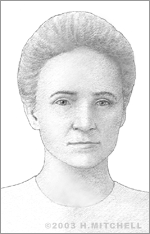Marie Curie
Poland-born Maria Sklodowska Curie is remembered as one of the world’s most brilliant scientists. Her achievements are seen as all the more remarkable because she was a woman working in a male-dominated field.
Born on November 7, 1867, Maria was an outstanding student who had a prodigious memory. Her father was a math and physics teacher and her mother a pianist, singer, and teacher. As one of five children, she worked as a teacher then a governess to help her family make ends meet and to earn money for her university education. In November 1891, she left Poland for the Sorbonne in Paris, where she first began using the French “Marie” instead of Maria. She graduated first in her class in physical sciences in 1893.
The following year, she began working in Gabriel Lippmann’s research laboratory. Soon after, she met Pierre Curie, an acclaimed professor at the School of Physics at the University of Paris. They married on July 26, 1895. Thus began their research partnership, focused on the study of radioactive substances, which would lead them to the discovery of two new radioactive elements: radium and polonium.
The Curies brought their first daughter, Irene, into the world in 1897. The following year, Marie set up a lab at the School of Physics, where she planned to work alongside her husband. While studying uranium ore, or pitchblend, the Curies found that the substance contained much more radioactivity than could be attributed to the uranium in it. They developed a very tedious method of refining large quantities of pitchblend to produce tiny samples of radioactive material. The first element they were able to isolate was polonium, named for Marie’s native country. They isolated radium next, which was even more radioactive – two million times more than uranium. They confirmed both elements’ existence by 1902.
The discoveries earned Curie her doctoral degree, the first to be awarded to a woman in Europe. Then, in 1903, she and Pierre were awarded the Nobel Prize in physics, presented to them jointly with Antoine Henri Bacquerel, who had discovered the phenomenon of natural radioactivity.
Eve, the Curies’ second daughter, was born in December of 1904. Upon returning to work, Marie was appointed chief assistant in Pierre’s lab. The following year, Pierre was killed in a street accident in Paris, leaving his wife to continue her work on radioactive elements alone. In 1906, she took on her husband’s professorship and was the first woman to teach at the Sorbonne.
In 1910, Curie published a treatise on radioactivity. She was awarded an unprecedented second Nobel Prize in 1911 in chemistry for the isolation of pure radium. In 1914, she helped establish the Radium Institute in Paris and was its first director. She continued to innovate, creating portable x-ray machines in World War I and training radiologist nurses to operate them on the battlefield. She and her daughter Irene worked together during the war on improvements to x-radiography.
Curie’s research eventually gave birth to the field of atomic physics. She began lecturing around Europe and in the United States, focusing her research on the chemistry of radioactive substances and possible medical applications for them. In 1932, she oversaw the founding of the Radium Institute in Warsaw, of which her sister, Bronia, became director.
On July 4, 1934, Curie died of leukemia at the age of 67, and her illness is believed to be a direct result of her frequent exposure to penetrating radiation. In fact, years after her death, physicists were able to use photographic film to discover fingerprints left in her lab books by radioactive deposits. In 1995, the French Government honored her memory by transferring her ashes and those of her husband to the Pantheon in Paris.
Curie’s work paved the way for her daughter, Irene, and her husband Frederic Joliot’s discovery of artificial radioactivity, for which the pair won the Nobel Prize in chemistry in 1935.


